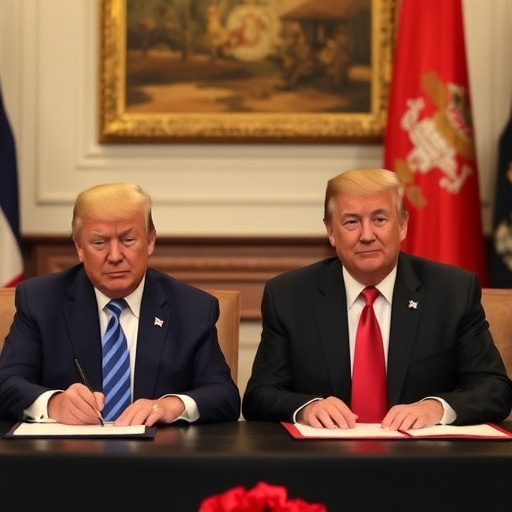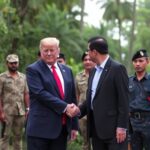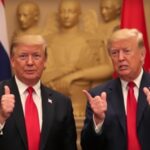Trump Co-Signs Historic Ceasefire Between Thailand and Cambodia, Securing Release of 18 Prisoners of War
In a stunning diplomatic coup that has reverberated across Southeast Asia, U.S. President Donald Trump co-signed a ceasefire agreement between Thailand and Cambodia on Tuesday in Kuala Lumpur, Malaysia. The landmark deal not only promises to halt a decade-long bloody border dispute but also paves the way for the immediate release of 18 Cambodian prisoners of war, marking a pivotal moment in regional peace efforts.
The agreement, brokered under the auspices of the Association of Southeast Asian Nations (ASEAN), arrives amid escalating tensions that have claimed hundreds of lives and displaced thousands along the contested Thai-Cambodian frontier. Trump‘s involvement—unexpected for a U.S. leader typically focused on domestic and great-power rivalries—has drawn global attention, underscoring America’s enduring role in fostering international stability.
Details of the ceasefire emerged from a closed-door summit hosted by Malaysian Prime Minister Anwar Ibrahim, where Thai Prime Minister Srettha Thavisin and Cambodian Prime Minister Hun Manet shook hands in a gesture of reconciliation. The document outlines demilitarization of the disputed Preah Vihear temple area, joint border patrols, and economic cooperation initiatives to prevent future flare-ups.
The Decade-Long Border Feud That Gripped Southeast Asia
The roots of the Thailand-Cambodia conflict trace back to a 1962 International Court of Justice ruling that awarded the ancient Preah Vihear temple to Cambodia, a decision that Thailand has long contested. What began as a territorial spat erupted into full-scale violence in 2008, with artillery exchanges and infantry clashes leaving over 30 soldiers dead in the first year alone. By 2011, the skirmishes had intensified, resulting in at least 28 fatalities and the evacuation of nearby villages.
Statistics from human rights organizations paint a grim picture: The border dispute has displaced more than 50,000 civilians since 2008, with intermittent fighting causing economic losses estimated at $1.2 billion for both nations combined. Cambodian forces, often outnumbered, suffered heavy casualties, leading to the capture of the 18 prisoners of war—mostly young conscripts held in Thai military facilities for years under harsh conditions.
“This conflict has scarred generations,” said Chum Mey, a Cambodian activist whose village was shelled in 2011. “Families torn apart, children without homes—it’s time for healing.” The prisoners of war, aged between 22 and 35, were detained following a 2018 ambush that killed five Thai soldiers, further souring relations. Their release, stipulated in the ceasefire, includes medical evaluations and repatriation flights funded by ASEAN.
Historical context reveals deeper layers: The dispute symbolizes post-colonial rivalries, with Thailand viewing the temple as a cultural icon and Cambodia as a symbol of national sovereignty. Failed bilateral talks in 2015 and 2020 only heightened suspicions, making external mediation essential.
Trump’s Surprise Entry into Thai-Cambodian Diplomacy
President Trump’s decision to co-sign the ceasefire has baffled observers, given his administration’s “America First” doctrine that prioritizes deals with China and trade pacts over distant border squabbles. Yet, sources close to the White House reveal that Trump saw an opportunity to burnish his legacy as a peacemaker, drawing parallels to his North Korea summits.
“The United States stands with our allies in Southeast Asia,” Trump declared during the signing ceremony, flanked by Thavisin and Manet. “This ceasefire isn’t just about Thailand and Cambodia—it’s about stopping wars before they spread. We’re bringing peace, and we’re doing it bigly.” His presence in Malaysia, en route from a G20 summit, was a last-minute addition, reportedly at the urging of U.S. Ambassador to ASEAN Yohannes Abraham.
Trump’s involvement adds a layer of U.S. credibility to the agreement. Historically, Washington has mediated in the region through backchannels, but a presidential co-signature is unprecedented. Analysts note that this move counters Chinese influence, as Beijing has courted both nations with infrastructure loans totaling $10 billion since 2013. By stepping in, Trump signals that America remains a vital partner in ASEAN security.
Critics, however, question the optics. “Trump’s foreign policy is transactional,” opined foreign policy expert Dr. Maria Gonzalez from Georgetown University. “Is this genuine diplomacy or a photo-op? Time will tell, but the prisoners of war getting home is a win no one can deny.” The co-signature includes U.S. commitments to monitor compliance via satellite imagery and joint exercises, potentially costing $50 million over five years.
Unpacking the Ceasefire Terms and Prisoner Release Protocol
At its core, the ceasefire agreement spans 15 articles, emphasizing de-escalation and humanitarian relief. Key provisions include a 10-kilometer buffer zone around Preah Vihear, where both militaries must withdraw within 30 days. Joint patrols, comprising 200 personnel from each side plus ASEAN observers, will enforce the truce, with violations triggering immediate UN intervention.
The release of the 18 Cambodian prisoners of war is the emotional centerpiece. Under Article 7, Thailand agrees to hand them over at the Malaysian border by week’s end, accompanied by International Red Cross officials. Each detainee will receive $5,000 in compensation from a joint fund, plus psychological support programs funded by Japan and Australia.
- Demilitarization Timeline: Full troop pullback by March 2024, verified by drones.
- Economic Incentives: $200 million ASEAN grant for border infrastructure, including roads and trade posts.
- Dispute Resolution: Permanent bilateral commission to handle future claims, with U.S. arbitration if needed.
Quotes from the prisoners’ families underscore the human stakes. “My son has been gone for six years,” said Sokha, mother of detainee Chamroeun. “This ceasefire brings him back to us—President Trump, thank you.” On the Thai side, military spokesperson General Narongphan Pumkaew stated, “We’ve held these men humanely; their release honors our commitment to peace.”
The agreement also addresses landmines, with a pledge to clear 15 square kilometers of contaminated territory—a legacy of the Vietnam War era that has killed 200 civilians since 2000. Experts estimate the clearance could take two years, involving Thai-Cambodian teams trained by U.S. specialists.
Leaders’ Reactions and Regional Ripple Effects
Thai Prime Minister Srettha Thavisin hailed the deal as “a new dawn for our shared border.” In a televised address, he emphasized economic benefits, projecting a 15% boost in cross-border trade within a year. Cambodia’s Hun Manet, son of longtime leader Hun Sen, called it “justice for our soldiers,” vowing to integrate the released prisoners into society through job training programs.
Malaysian host Anwar Ibrahim praised Trump’s role: “His bold step has united ASEAN like never before.” Yet, not all reactions are jubilant. Opposition voices in Thailand’s parliament decry the concessions as “weakness,” while Cambodian nationalists demand full temple access without Thai interference.
Regionally, the ceasefire eases fears of spillover. Vietnam and Laos, wary of refugee influxes, have offered mediation support. In Washington, Senate Foreign Relations Committee Chair Bob Menendez commended the effort: “Trump’s co-signature reinforces U.S. leadership in Asia—bipartisan kudos on this one.”
The deal’s success hinges on implementation. Past ceasefires, like the 2013 truce, faltered due to mistrust. This time, with Trump’s endorsement, international pressure mounts for adherence, potentially averting a humanitarian crisis.
Path Forward: Boosting Stability and U.S. Ties in Southeast Asia
Looking ahead, the ceasefire opens doors to broader collaboration. Thailand and Cambodia plan a “Peace Corridor” initiative, linking tourism sites around Preah Vihear to generate 10,000 jobs by 2025. U.S. involvement could expand to counterterrorism training, given rising threats from Myanmar’s instability.
Trump’s administration eyes this as a template for other hotspots, like the South China Sea disputes. “We’ve shown that American diplomacy works,” a State Department official noted anonymously. For the released prisoners of war, reintegration programs will focus on trauma care, with NGOs like Doctors Without Borders committing $2 million.
Ultimately, this agreement could redefine U.S.-ASEAN relations, fostering trade deals worth $500 billion annually. As border communities rebuild, the world watches: Will Trump’s ceasefire endure, or is it another fleeting accord in a volatile region? The stakes—for peace, prosperity, and American influence—are higher than ever.









